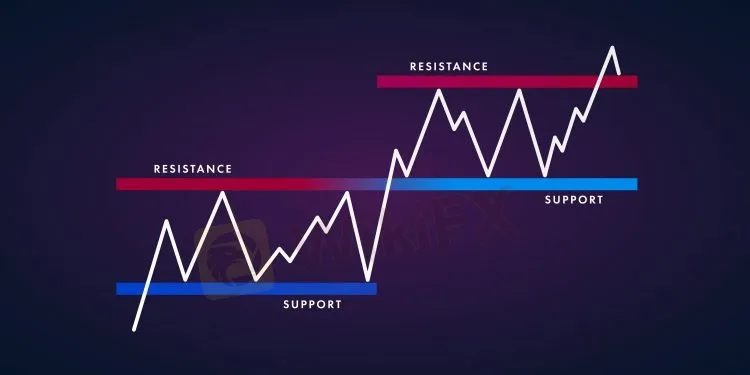简体中文
繁體中文
English
Pусский
日本語
ภาษาไทย
Tiếng Việt
Bahasa Indonesia
Español
हिन्दी
Filippiiniläinen
Français
Deutsch
Português
Türkçe
한국어
العربية
Traders Must Know The Roles of Support and Resistance Levels
Abstract:Support and resistance levels assist traders to understand the market better. As we all know, anyone who has a better understanding of the market has a sharper edge compared to those who don’t

Indeed, knowledge is power in trading.
Basically, support levels indicate prices that a currency will not likely fall below. Conversely, resistance levels indicate prices that a currency will probably not exceed.
Support and resistance levels can be seen as the ‘oracle’ of market trends because these can predict whether a current trend will keep going or not more accurately. Accuracy is everything in trading. A fool-proof information enables traders to confidently enter or close a position, or place a stop or a limit.
Technical Analysis
Technical analysts use charts and other tools to study and analyze the market history and come up with a pattern that may aid them to make a prediction of future activities. But even with the capability to archive past activities and generate patterns from it, past performance is not a guarantee of future results.
This method looks into the supply and demand surrounding specific security and currency. It is more focused on what actually happens, instead of coming up with an explanation about why something happens.
One of the basic assumptions of technical analysis is that history has a tendency of repeating itself.
Currencies move in various directions. If it moves up, it will not stay there forever; we can possibly see it in downtrends or range. Trends can be long or short term, and certainly, it will not march on one direction indefinitely. There will be a frequent encounter of either support or resistance.
Support and Resistance: A Closer Look
A currency has reached a support level if it undergoes a difficulty of falling below a specific price.
This happens most of the time because a currencys drop in value results in there being more buyers than sellers. With this, the floor is created because traders dive in and snap up purchases.
On the other hand, a currency has reached a resistance level if it undergoes a difficulty rising above a specific value. It usually happens when the number of sellers exceeds the number of buyers after a currency has experienced a significant increase in price.
The Reversal of Their Roles
Even with a better prediction that support and resistance levels provide, the information generated from them is not always confirmed.
To give you an example, if a currency exceeds past resistance, it can pull the interests of a lot of investors, and as a result, increases its prices.
On the reversal, other investors might possibly wait for the currency to decrease some value, mainly if it increased in price upon surpassing resistance. With this taking place, investors who hold back could be a fresh new source of support.
If a currency sinks below support, this situation could be a contributing factor to initiate a bigger sell-off. This situation can happen when a currency reacts to major news on political or economic development. So the old support could become the new resistance as the currency finds it hard to achieve its last price range.
Highly-Significant Levels
It is still the classic psychology that plays a major role in an investor‘s decisions. These are not entirely because of the outside influences that we can see and hear. It’s more of the investors psychology. With this, the global market will frequently create levels of support and resistance largely driven by psychology.
There is no doubt that support and resistance levels are crucial. By carefully analyzing and identifying these levels, investors can pinpoint the ranges that currencies are trading in and make more accurate transactions.

Disclaimer:
The views in this article only represent the author's personal views, and do not constitute investment advice on this platform. This platform does not guarantee the accuracy, completeness and timeliness of the information in the article, and will not be liable for any loss caused by the use of or reliance on the information in the article.
Read more

Unmasking the ‘Datuk’: The Anatomy of a RM638,205 Investment Scam
Authorities in Malaysia have launched an extensive investigation into a fraudulent stock investment scheme, which has resulted in losses amounting to RM638,205.

Unmasking the ‘Datuk’: The Anatomy of a RM638,205 Investment Scam
Authorities in Malaysia have launched an extensive investigation into a fraudulent stock investment scheme, which has resulted in losses amounting to RM638,205.

ATFX Enhances Trading Platform with BlackArrow Integration
ATFX integrates the BlackArrow trading platform, offering advanced tools for forex, crypto, and stocks with automation and real-time analytics for traders.

Exposing the Truth: What Happened with the Losses of Thousands of Dollars on the GlobTFX Platform?
The facts are clear and undeniably shocking—GlobTFX has caused significant financial losses to well-known traders in the Arab world. Eighteen victims have confirmed a total loss exceeding $22,372! But this is just the tip of the iceberg…
WikiFX Broker
Latest News
Germany's Election: Immigration, Economy & Political Tensions Take Centre Stage
WikiFX Review: Is IVY Markets Reliable?
Brazilian Man Charged in $290 Million Crypto Ponzi Scheme Affecting 126,000 Investors
Become a Full-Time FX Trader in 6 Simple Steps
ATFX Enhances Trading Platform with BlackArrow Integration
IG 2025 Most Comprehensive Review
Construction Datuk Director Loses RM26.6 Mil to UVKXE Crypto Scam
SEC Drops Coinbase Lawsuit, Signals Crypto Policy Shift
Should You Choose Rock-West or Avoid it?
Scam Couple behind NECCORPO Arrested by Thai Authorities
Currency Calculator






